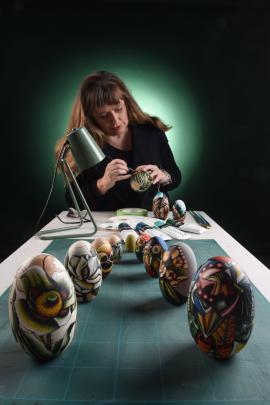A Dunedin art teacher has taken the concept of Russian nesting dolls and turned it into a canvas for her art, discovers Rebecca Fox.
Flowers, pop stars, vintage icons, old medical posters and plants - you name it, Kezia Field has probably painted it, but not on canvas.
Field has chosen a different format for her art. She paints on undecorated Russian nesting dolls she imports from overseas.
She got the idea from the internet and thought she would give it a go, painting a Frida Kahlo on a nesting doll, and has not looked back.
''I really enjoyed it.''
The wooden dolls come from Russia and she has recently found different sized dolls in different shapes.
''When I first started they were smaller. Now the shapes are bigger so I can do more detailed studies. It can be hard on the eyes doing the detailed stuff.''
It was a big step for the art teacher who had been too busy to do much of her own work in recent years.
But she has found it rather addictive, sitting down at 9pm most days to paint the intricate works, each of which takes about a week.
''I've really had to manage my time. It's amazing how much energy I've got when I sit down to do them. It's like meditation. You get lost in the works.''
One of the challenges is to ensure each half of the dolls match. ''That can be fun.''
As well as satisfying an urge to create her own work, she has discovered it has also helped her teaching.
''It's been great professional development and the girls (her students) are really into it.''
It also helps as she often says to her pupils that having a point of difference in their art is a good thing.
''I'm doing what I preach. It's good role-modelling, especially to young women.''
She starts by finding an image she thinks will work on the dolls. Then she narrows down her selection.
''It can take a lot of time.''
Field often goes through fads of painting dolls to certain themes: she has done a series based on vintage medical posters, art nouveau and one on women in art.
''I like to empower women as much as possible and this is one way I can amplify it.''
Many of her dolls are decorated in a botanical themes as she is also a keen gardner. One of her latest is an artichoke design. Another had an olive design as her daughter is named Olive.
''As a child, I had a thing for artichokes; they've got such great structure.''
The death of her mother had also inspired her to paint a series featuring cyclamens. Her mother used to give her cyclamens whenever she came to visit from Christchurch.
She is still experimenting with materials to coat the dolls to protect the paint from handling.
''They're so tactile people want to touch them, but they're not toys; they're art works.''
Field is also a keen photographer so has been experimenting with different photos of the dolls to post on the internet. She has been photographing the dolls with the plants they depict.
''It's good to combine the plants and photography.''
Russian dolls
- Also called matryoshka dolls or babushka dolls
- The first Russian nesting doll set appeared in Moscow in 1890s. The doll set consisted of eight dolls of decreasing sizes placed one inside the other. All eight dolls depicted children
- Were often given as a present to young women from their loved ones
- In 1900, the dolls earned a bronze medal at the World Exhibition in Paris
- Traditionally made from linden or birch
- The number of nested dolls in a set varies from two to 60. However, a classic set has five nested figures
— Source: MasterRussia.com















